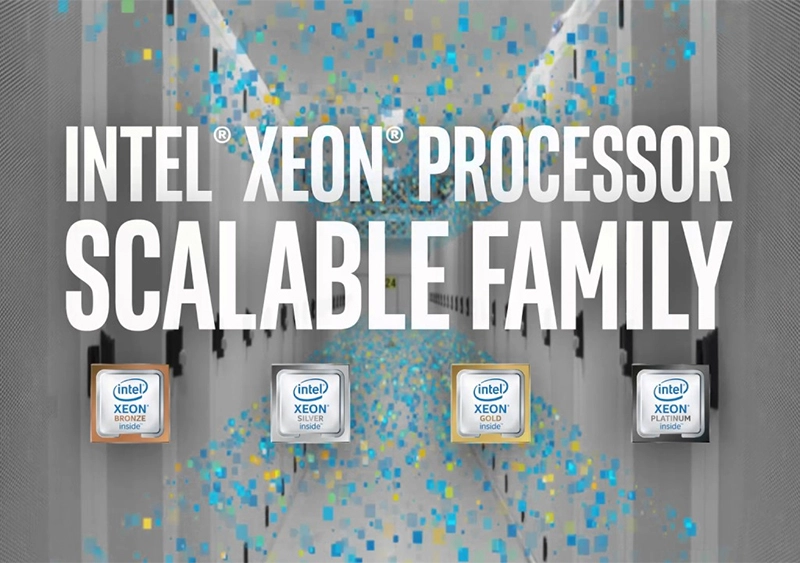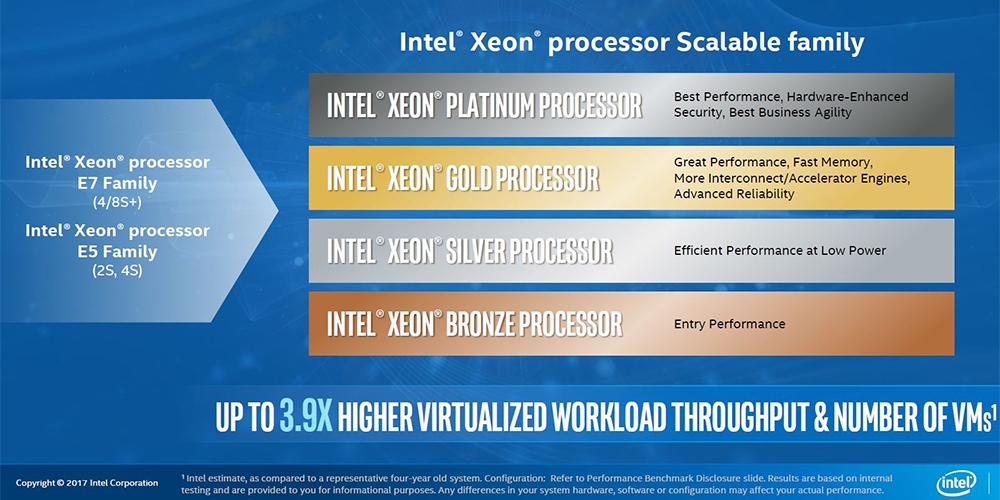
New Name, More Flexibility
Intel is switching up it's long-standing Xeon processor family with a new naming scheme and lineup of server-grade CPUs. The new lineup is said to be the new foundation for secure, agile, and multi-cloud data centers. In the past, the Intel Xeon family of processors were ordered from the lowest to highest tiers by using a numbering scheme ranging from 3, 5, and 7 respectively. From now on, the new Intel Xeon processor series will be known as the Intel Xeon Processor Scalable Family.

The new branding from Intel does more than signify an update to the latest Skylake architecture, it also adds more CPU variations to the lineup to ensure more flexibility in terms of applications and price points to help accommodate customers with specific use cases or requirements. Each CPU is categorized in different levels signified by a type of metal. From Bronze to Platinum, each level offers different features instead of a simple core count increase as was commonplace in the E, EP, and EX series branding platform. These features range from integrated options including Ethernet, Intel Omni-Path, and quick accelerators which offer 2x the compression performance, to more specific support for new technologies like Intel's new Optane SSDs, as well as a multitude of workload-optimized frameworks.
The Upgrade to Skylake-SP
While the new branding and added CPU options including new features is exciting. It's important to remember that there is still a performance upgrade to be had, thanks to the move to the Skylake Scalable Performance (SP) architecture. Intel Skylake SP is the code name for Intel's series of server multiprocessors based on the Skylake microarchitecture.
The highest available core count, within the new series, peaks at a massive 28 cores with new on-die interconnects. This means scalability and performance are both positively affected. Overall performance gains compared to the Broadwell microarchitecture equates to around 50%, while each individual core has a 20% increase in performance. In regards to other system components, there is a 50% or more increase in memory bandwidth, alongside a 50% increase in PCIe bandwidth.
To help our readers with the transition from previous the Intel Xeon generation to the new Intel Xeon Processor Scalable Family, we created a partial conversion listing below:
| Broadwell CPU | Clock Speed (GHz) | Core Count | Skylake CPU | Tier | Clock Speed (GHz) | Core Count |
|---|---|---|---|---|---|---|
| N/A | N/A | N/A | 8180 | Platinum | 28 | 2.5 |
| E5-2699A v4 | 2.4 | 22 | 8164 | Platinum | 26 | 2 |
| N/A | N/A | N/A | 6154 | Gold | 18 | 3 |
| E5-2698 v4 | 2.2 | 20 | 6152 | Gold | 22 | 2.1 |
| E5-2660 v4 | 2 | 14 | 5120 | Gold | 14 | N/A |
| E5-2650 v4 | 2.2 | 12 | 5118 | Gold | 12 | N/A |
| E5-2640 v4 | 2.4 | 10 | 4116 | Silver | 12 | N/A |
| E5-2630 v4 | 2.2 | 10 | 4114 | Silver | 10 | N/A |
| E5-2609 v4 | 1.7 | 8 | 3106 | Bronze | 8 | N/A |
| E5-2603 v4 | 1.7 | 6 | 3104 | Bronze | 6 | N/A |
Re-Architecting the Future for Scalability
Intel understands that data center technology must evolve to address new customer requirements for performance, security, and agility. By re-architecting and unifying the Intel Xeon Processor Family for scalability, they are hoping to provide easy-to-use solutions that maximize platform capabilities.
On top of all the new features that help add performance and compatibility with the newest technologies, the CPU architecture itself has not been forgone. The Skylake-SP architecture boasts nearly double overall performance than the previous Broadwell architecture to offer a truly special CPU lineup. With more server-grade processors being offered to a broader range of users than ever before, Intel looks poised to offer one of its biggest platform advancements yet.

What You Need to Know About the New Intel Xeon Processor Scalable Family
New Name, More Flexibility
Intel is switching up it's long-standing Xeon processor family with a new naming scheme and lineup of server-grade CPUs. The new lineup is said to be the new foundation for secure, agile, and multi-cloud data centers. In the past, the Intel Xeon family of processors were ordered from the lowest to highest tiers by using a numbering scheme ranging from 3, 5, and 7 respectively. From now on, the new Intel Xeon processor series will be known as the Intel Xeon Processor Scalable Family.

The new branding from Intel does more than signify an update to the latest Skylake architecture, it also adds more CPU variations to the lineup to ensure more flexibility in terms of applications and price points to help accommodate customers with specific use cases or requirements. Each CPU is categorized in different levels signified by a type of metal. From Bronze to Platinum, each level offers different features instead of a simple core count increase as was commonplace in the E, EP, and EX series branding platform. These features range from integrated options including Ethernet, Intel Omni-Path, and quick accelerators which offer 2x the compression performance, to more specific support for new technologies like Intel's new Optane SSDs, as well as a multitude of workload-optimized frameworks.
The Upgrade to Skylake-SP
While the new branding and added CPU options including new features is exciting. It's important to remember that there is still a performance upgrade to be had, thanks to the move to the Skylake Scalable Performance (SP) architecture. Intel Skylake SP is the code name for Intel's series of server multiprocessors based on the Skylake microarchitecture.
The highest available core count, within the new series, peaks at a massive 28 cores with new on-die interconnects. This means scalability and performance are both positively affected. Overall performance gains compared to the Broadwell microarchitecture equates to around 50%, while each individual core has a 20% increase in performance. In regards to other system components, there is a 50% or more increase in memory bandwidth, alongside a 50% increase in PCIe bandwidth.
To help our readers with the transition from previous the Intel Xeon generation to the new Intel Xeon Processor Scalable Family, we created a partial conversion listing below:
| Broadwell CPU | Clock Speed (GHz) | Core Count | Skylake CPU | Tier | Clock Speed (GHz) | Core Count |
|---|---|---|---|---|---|---|
| N/A | N/A | N/A | 8180 | Platinum | 28 | 2.5 |
| E5-2699A v4 | 2.4 | 22 | 8164 | Platinum | 26 | 2 |
| N/A | N/A | N/A | 6154 | Gold | 18 | 3 |
| E5-2698 v4 | 2.2 | 20 | 6152 | Gold | 22 | 2.1 |
| E5-2660 v4 | 2 | 14 | 5120 | Gold | 14 | N/A |
| E5-2650 v4 | 2.2 | 12 | 5118 | Gold | 12 | N/A |
| E5-2640 v4 | 2.4 | 10 | 4116 | Silver | 12 | N/A |
| E5-2630 v4 | 2.2 | 10 | 4114 | Silver | 10 | N/A |
| E5-2609 v4 | 1.7 | 8 | 3106 | Bronze | 8 | N/A |
| E5-2603 v4 | 1.7 | 6 | 3104 | Bronze | 6 | N/A |
Re-Architecting the Future for Scalability
Intel understands that data center technology must evolve to address new customer requirements for performance, security, and agility. By re-architecting and unifying the Intel Xeon Processor Family for scalability, they are hoping to provide easy-to-use solutions that maximize platform capabilities.
On top of all the new features that help add performance and compatibility with the newest technologies, the CPU architecture itself has not been forgone. The Skylake-SP architecture boasts nearly double overall performance than the previous Broadwell architecture to offer a truly special CPU lineup. With more server-grade processors being offered to a broader range of users than ever before, Intel looks poised to offer one of its biggest platform advancements yet.




.jpg?format=webp)